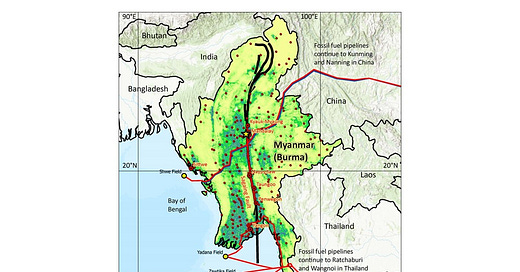Earthquake Tears Through Myanmar
Leaving uncertainty, a humanitarian crisis, and to China, a dilemma (Part 1)
Large natural disasters can alter the military and political structure of nations already weakened by civil war and fragile economics. A magnitude 7.7 earthquake ruptured along the historically active Sagaing Fault, tearing through Myanmar's economic and political center on March 28, 2025 (Figure 1). According to the Myanmar Red Cross Society (MRCS) nearly 3 900 people have died, 5,742 have been injured, and 441 people remain missing (Other reports are at least a thousand deaths higher). Official figures from junta (Tatmadaw) controlled areas indicate the destruction of 48,834 residential buildings, thousands of schools, monasteries and nunneries, pagodas and stupas, departmental offices, and hundreds of health care facilities, plus destruction in other areas is reported to be significant. Key infrastructure, such as railroads, highways, bridges were damaged or destroyed. Earthquake epicenter, the causative fault, and much of the destructive aftermath was concentrated in the “Bamar Heartland,” the historical, cultural, administrative and agricultural center of the nation and home of the Burmese, the nation’s largest ethnic group. A center that is the demographic and resource support of the junta, its leadership, and troops.
History shows that large natural disasters in weakened states have led to regime and military changes. In 2023, two years before Syria’s Assad regime fell, a devastating earthquake further exposed that regime’s inability to govern effectively. Investigative reports revealed that the regime had deliberately obstructed aid to all of Syria's opposition-held areas, some of the worst-struck in the earthquake. The earthquake’s aftermath likely accelerated societal disenchantment, undermined the regime’s support, and worsened an already dire humanitarian crisis (civil war). However, it remains undetermined if the earthquake was a key factor in the fall of the Assad regime.
It has been suggested that the March 2025 earthquake could lead to fall of the junta in Myanmar. Presently there is a growing, albeit weakly united, political and military opposition with the potential for filling the national leadership void that the junta and the earthquake have created. These new conditions show potential for change but with a very key hurdle: China’s historic, geo-strategic and economic interests in its neighbor, and its view that the Myanmar is too ethnically and politically divided to form a stable democratic government. To evaluate the potential regime change, let us take a closer look at the pre-earthquake conditions, the earthquake’s impact on the junta’s and opposition’s military operations, and Myanmar’s possible post-earthquake pathways. Continued as Earthquake Tears Through Myanmar (Part 2) on substack.com. To be posted soon.
Figure 1. Map showing key geologic elements of the March 28, 2025 Myanmar earthquake with population density, key cities, and oil and gas export pipelines.





